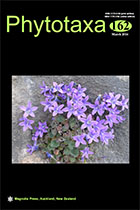Abstract
Drepanolejeunea (Spruce 1884: 186) Stephani (1891: 209), with about 110 currently accepted species, is the fourth largest genus of Lejeuneaceae (following Cololejeunea (Spruce 1884: 291) Stephani (1891: 208), Lejeunea Libert (1820: 373), and Cheilolejeunea (Spruce 1884: 251) Stephani (1890: 284) (He et al. 2012). Although Drepanolejeunea is a diverse pantropical genus, it is characterized and easily distinguished from other related genera by the 1) erect to widely divergent lobes of underleaves without a basal disc, 2) transverse section of stem with 7 cortical cells and 3 medullary cells, 3) presence of ocelli at least at base of leaf lobe), 4) proximal hyaline papilla, 5) pycnolejeuneoid leaf sequence of gynoecial innovation (if present), 6) inflated perianths usually with various projections near apex, and 7) asexual reproduction by means of cladia or caducous leaves (Zhu & So 2001; He et al. 2012; Pócs et al., 2013). The genus has been classified in a separate subtribe, Drepanolejeuneinae Gradstein (2013: 14), together with Vitalianthus Schuster & Giancotti (1993: 447).

